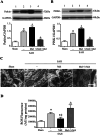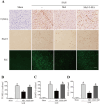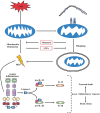Melatonin-mediated mitophagy protects against early brain injury after subarachnoid hemorrhage through inhibition of NLRP3 inflammasome activation
- PMID: 28546552
- PMCID: PMC5445068
- DOI: 10.1038/s41598-017-02679-z
Melatonin-mediated mitophagy protects against early brain injury after subarachnoid hemorrhage through inhibition of NLRP3 inflammasome activation
Erratum in
-
Author Correction: Melatonin-mediated mitophagy protects against early brain injury after subarachnoid hemorrhage through inhibition of NLRP3 inflammasome activation.Sci Rep. 2024 Sep 18;14(1):21823. doi: 10.1038/s41598-024-71815-3. Sci Rep. 2024. PMID: 39294188 Free PMC article. No abstract available.
Abstract
The NLRP3 inflammasome is activated in the early period following subarachnoid hemorrhage(SAH), resulting in inflammatory responses. Recent studies have shown that activation of NLRP3 inflammasome is suppressed by autophagy, but the potential mechanism is unclear. In this study, we examined whether mitophagy was involved in the beneficial effect of melatonin and its relationship with NLRP3 inflammasome activation after SAH. In total, 130 adult-male SD rats were randomly divided into four groups: sham group, SAH + vehicle group, SAH + melatonin group, and SAH + 3-methyladenine (3-MA) + melatonin group. Brain samples were used for brain water content analysis, ROS assay, Western blot, immunohistochemistry and transmission electron microscopy. The results showed that melatonin treatment markedly increased the expression of both autophagy markers(LC3-II/LC3-I and Atg 5), and mitophagy markers(Parkin and PINK-1) following SAH induction. Additionally, melatonin treatment attenuated pathological changes in mitochondria and reduced ROS generation, which are closely related to NLRP3 inflammasome activation. Consequently, melatonin-mediated upregulation of proteins associated with mitophagy inhibited NLRP3 inflammasome activation and significantly reduced pro-inflammatory cytokine levels after SAH. Conversely, 3-MA, an autophagy inhibitor, reversed these beneficial effects of melatonin on mitophagy and the NLRP3 inflammasome. These results suggest that mitophagy-associated NLRP3 inflammasome inhibition by melatonin is neuroprotective against early brain injury post-SAH in rats.
Conflict of interest statement
The authors declare that they have no competing interests.
Figures







Similar articles
-
Honokiol-Mediated Mitophagy Ameliorates Postoperative Cognitive Impairment Induced by Surgery/Sevoflurane via Inhibiting the Activation of NLRP3 Inflammasome in the Hippocampus.Oxid Med Cell Longev. 2019 Feb 24;2019:8639618. doi: 10.1155/2019/8639618. eCollection 2019. Oxid Med Cell Longev. 2019. PMID: 30918581 Free PMC article.
-
Hydrogen-Rich Saline Attenuated Subarachnoid Hemorrhage-Induced Early Brain Injury in Rats by Suppressing Inflammatory Response: Possible Involvement of NF-κB Pathway and NLRP3 Inflammasome.Mol Neurobiol. 2016 Jul;53(5):3462-3476. doi: 10.1007/s12035-015-9242-y. Epub 2015 Jun 20. Mol Neurobiol. 2016. PMID: 26091790
-
Fluoxetine-enhanced autophagy ameliorates early brain injury via inhibition of NLRP3 inflammasome activation following subrachnoid hemorrhage in rats.J Neuroinflammation. 2017 Sep 13;14(1):186. doi: 10.1186/s12974-017-0959-6. J Neuroinflammation. 2017. PMID: 28903766 Free PMC article.
-
Anti-Inflammatory Activity of Melatonin: a Focus on the Role of NLRP3 Inflammasome.Inflammation. 2021 Aug;44(4):1207-1222. doi: 10.1007/s10753-021-01428-9. Epub 2021 Mar 2. Inflammation. 2021. PMID: 33651308 Review.
-
Interplay Between NLRP3 Inflammasome and Autophagy.Front Immunol. 2020 Oct 9;11:591803. doi: 10.3389/fimmu.2020.591803. eCollection 2020. Front Immunol. 2020. PMID: 33163006 Free PMC article. Review.
Cited by
-
The Role of NLRP3 Inflammasome in Cerebrovascular Diseases Pathology and Possible Therapeutic Targets.ASN Neuro. 2021 Jan-Dec;13:17590914211018100. doi: 10.1177/17590914211018100. ASN Neuro. 2021. PMID: 34053242 Free PMC article. Review.
-
Honokiol-Mediated Mitophagy Ameliorates Postoperative Cognitive Impairment Induced by Surgery/Sevoflurane via Inhibiting the Activation of NLRP3 Inflammasome in the Hippocampus.Oxid Med Cell Longev. 2019 Feb 24;2019:8639618. doi: 10.1155/2019/8639618. eCollection 2019. Oxid Med Cell Longev. 2019. PMID: 30918581 Free PMC article.
-
Targeting NLRP3 Inflammasome in Translational Treatment of Nervous System Diseases: An Update.Front Pharmacol. 2021 Aug 30;12:707696. doi: 10.3389/fphar.2021.707696. eCollection 2021. Front Pharmacol. 2021. PMID: 34526897 Free PMC article. Review.
-
Cornuside alleviates cognitive impairments induced by Aβ1-42 through attenuating NLRP3-mediated neurotoxicity by promoting mitophagy.Alzheimers Res Ther. 2025 Feb 19;17(1):47. doi: 10.1186/s13195-025-01695-w. Alzheimers Res Ther. 2025. PMID: 39972387 Free PMC article.
-
Mitophagy and cGAS-STING crosstalk in neuroinflammation.Acta Pharm Sin B. 2024 Aug;14(8):3327-3361. doi: 10.1016/j.apsb.2024.05.012. Epub 2024 May 13. Acta Pharm Sin B. 2024. PMID: 39220869 Free PMC article. Review.
References
-
- Connolly, E. S. Jr. et al. Guidelines for the management of aneurysmal subarachnoid hemorrhage: a guideline for healthcare professionals from the American Heart Association/american Stroke Association. Stroke43, 1711–1737, doi:10.1161/STR.0b013e3182587839 (2012). 10.1161/STR.0b013e3182587839 - DOI - PubMed
-
- Dumont, A. S. et al. Cerebral vasospasm after subarachnoid hemorrhage: putative role of inflammation. Neurosurgery53, 123–133, discussion 133–125 (2003). - PubMed
Publication types
MeSH terms
Substances
LinkOut - more resources
Full Text Sources
Other Literature Sources

